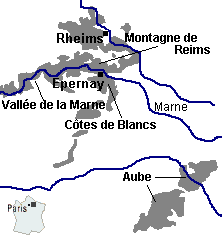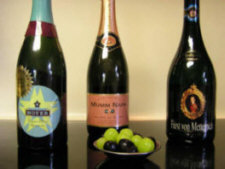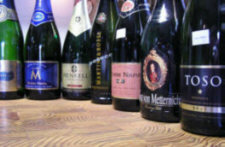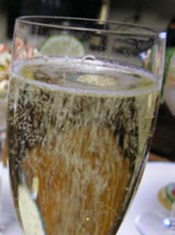|
Champagne's Bubble Magic
|
|
By: Thomas M. Ciesla January, 2006
|
|
Champagne, once the drink of Kings, is truly the wine of celebration, but did you know that Champagne tastes better when it has tiny bubbles? That hypnotic train of rising bubbles is key to the drinks flavor and aroma, so say researchers from France's Champagne region. But before we begin discussing nucleation sites, surface tension, and absorption rates of macromolecules, let's review Champagne's history and characteristics.
|
 The Champagne Region
|
|
La Champagne, the region, lies roughly 100 miles east and north of Paris. It is a region of timeless beauty where it is believed that the Romans introduced viticulture to this region, as documented by Pliny in 79 A.D. In the 11th century many vineyards became the property of the abbeys in the region – bequeathed to them by nobility who never returned from the Crusades. For centuries this region was known for its still wines, which were consumed locally while still quite young.
|
|
The sparkling 'Champagne' we know today, didn't exist until the 17th century. The bubbles arise from Champagne's cold climate and short growing season. The grapes are picked late in the year. This doesn't leave enough time for the naturally occurring yeasts on the grape skins to convert the sugar in the pressed grape juice into alcohol before the winter cold put a temporary stop to fermentation. Spring's warmer temperatures would restart the fermentation process after the wine had already been bottled, thus trapping the carbon dioxide
|
 Close Up Of A Champagne Bubble
Photo by Gerard Liger-Belair
|
|
The French saw these bubbles as bad winemaking, but the English took a fancy to these fizzy wines. They worked on ways to enhance the production of bubbles and put the wine in stronger glass bottles to withstand the increased pressures. When word got back to the French winemakers about these advances, they decided to perfect and control this secondary fermentation, and embraced use of the stronger bottles from England. Up till then, most cellar masters worked with iron masks to cover their faces because of the constant risk of exploding bottles, which sent glass shards into their eyes, often causing blindness.
|
|
Dom Perignon, a monk at the Abbey of Hautvilles near Epernay was not the inventor of 'sparkling wines', as legend has it. Quite the opposite; he and his contemporaries were challenged to bring an end to these exploding bottles, which often destroyed up to 20 percent (and sometimes as much as 40 percent) of production. After England embraced these wines, Dom Perignon and others (such as Frere Jean Oudart, cellar master at the Abbey of Saint Pierre cux Monts de Chalons), created a system of blending wines to control flavor, and developed a method to filter the wines which were often cloudy. But it was not until the 1800s that a pharmacist named Francios showed how to control the pressure within the bottle by measuring the residual sugar in the wine to produce a specific volume of carbon dioxide.
|
|
Viola! The problem of exploding bottles ended, triggering an era of prosperity in the Champagne region throughout the 19th century. However, a series of devastating events shut down production in this area and most of France. Late in the century, Europe was invaded by the vine disease Phylloxera. Before a solution was found France lost half of its vineyards as did other viticultural areas in Europe. Shortly thereafter, the Prohibition in the United States dried up the export market causing financial hardship for European winemakers. Finally, World War I and II turned French vineyards into battlefields, destroying most estates and empting cellars across France. After the wars, the Champagne region rebuilt itself and the Treaty of Versailles reaffirmed that only sparkling wines made in a specific set of 'departments' (regions) in Champagne may be referred to as 'Champagne'.
|
|
Le Champagne, the wine, is traditionally made only from Pinot Noir, Pinot Meunier, and Chardonnay. In the Champagne region, the grapes are picked early when sugar levels are low and acid levels higher. The juice is pressed off the grapes quickly to keep the juice white, even though Pinot Noir and Pinot Meunier are red grapes. The juice then undergoes two fermentations in the process known as Methode` Champenoise (known as Methode Traditionnelle since 2005).
|
|
The first fermentation is the same as with any other wine, though this 'base wine' is not very palatable due to higher acid levels. This wine is then blended and a cocktail of yeast and sugar is added to each bottle. It's during this second fermentation that the carbon dioxide is trapped in the bottle creating the famous sparkling effervescence.
After aging from 1-3 years, each bottle undergoes the process of 'riddling', where each bottle is tilted neck-down, and then slowly rotated a small amount each day to move the sediment into the neck of the bottle. Once all the sediment has moved into the neck of the bottle, a process known as 'disgorgement' is used to remove the sediment. In modern disgorgement, the neck of the bottle is frozen and the plug of ice containing the sediment is removed with little loss of wine. A 'dosage' is added to compensate for the lost volume and the bottle re-sealed
|
The majority of Champagne is a blend of grape varieties and vintages. Pinot Noir, a deep-blue grape with white juice, lends a finished body as well as the elegant red berry aromas typical of that variety. Pinot Meunier is also a dark grape with white juice provides a supple round fruitiness to the wine. Chardonnay, the most costly of the three fruits, lends elegance, finesse, crispness and delicacy to the wine. Together, these grapes are used to make four types of Champagne: Non-Vintage (N.V.), Vintage, Rose`, and Prestige
Cuvées.
|
 Left to Right: Sparkling Wines From Texas, California, and Germany
|
|
Non Vintage
This Champagne is blended from wines of several years to achieve a House style, often made by blending thirty or forty different wines. Non-vintage Champagne cannot be sold until it is 15 months old, though most wineries will keep the wine in their cellars much longer. As the bottle ages, the Champagne will become softer on the palate, though it's not recommended to keep a bottle longer than originally cellared by the maker.
Vintage
This is Champagne made by blending wines from a specific year, when the harvest was of sufficient quality to be declared a “vintage”. Vintage Champagne must be aged 39 months before being sold, that is, three years after the first January following harvest.
Rosé
This Champagne is made in one of two ways: first by maceration of dark grapes during pressing so the color leeches from the skins into the juice, or by adding a small amount of the red wine from the Champagne region. The maceration method is expensive and difficult to control, but most Champagne drinkers would say it's worth it.
Prestige Cuvées
The House of Moet Chandon invented the Cuvée Prestige in 1921. Today most Champagne houses produce a special bottle in a vintage year that represents the pinnacle of the house's achievement. These bottles can cost three times that of a non-vintage and double the price of a Vintage bottle. This higher price reflects the grapes selected from the top-producing vineyards, gently pressed, the juices carefully blended and then bottled in a specially shaped bottle.
For each of these Champagne types, the dosage (mixture of wine and sugar) introduced during disgorgement determines the sweetness of the final product, which is divided into six categories ranging from the driest to the sweetest::
Nature: 0%,
Brut: 0-2%,
Extra-dry: 1.5 – 2.5%,
Sec: 2-4%,
Demi-sec: 4-6%,
Doux: over 6%
In general, the drier the Champagne, the higher quality base wine is required to yield a balanced champagne, while the sweetest cuvees are usually made with lesser wines. Of course, the Extra Dry category is confusing for most, since it is neither the least nor the most sweet.
|
|
Champagne By Another Name?
|

|
|
So far we've been discussing sparkling wine made in Champagne, but as we all know, sparkling wines are made all over the world. The efforts of wine makers in the Champagne region to restrict the use of the term 'champagne' are both self-serving and rooted in the reality of 'terroir'. Grapes grown in this region of the world are influenced by the unique climatic and geologic conditions, especially the pronounced chalky soils found here, which contribute to the minerality of these wines. A lengthy set of requirements specify most aspects of viticulture. This includes vine pruning, the yield of the vineyard, the degree of pressing applied to the grapes, and the time that the bottles must age.
|
|
Even sparkling wines made in France other than the Champagne region cannot be called Champagne and are instead called Cremants or more recently Vine Mousseux. In Italy it's called Spumante, or Prosecco if made from the prosecco grape of the Torino region. In Germany it's known as Sekt, and in Spain it's called as Cava.
While most countries have labeling laws that protect wine producing regions such as Champagne, some allow wine producers to use the term 'champagne' on their labels. In the United States, Congress passed a law claiming that the term 'champagne' was semi-generic, thereby allowing winemakers to put this word on their labels.
|

|
|
When champagne is poured into glass, it immediately forms a froth bigger than the volume of the wine poured. This fleeting froth disintegrates in a few seconds, creating a circle of bubbles at the edge of the glass – the collar – fed by nucleated bubbles in the champagne glass. This is how we define effervescence, from the Latin fervere which means 'to boil'. When disappointed by the effervescence of the champagne in his glass, a consumer is likely to underrate all of the wines qualities.
|
|
Gerard Liger-Belair is a self-described 'bubble addict'. After photographing and studying the development of bubbles in various carbonated beverages, he focused his considerable intellect on Champagne's effervescence for his PhD dissertation, working with Moet Chandon's headquarters in Epernay. Since then, he has become a major contributor to the physics of carbonation.
Mr. Liger-Belair is first and foremost a physicist, with penchant for studying the physical and dynamic properties of carbonation. For him, the effervescence in sparkling wine provides an ideal platform for bubble research. In a research article for the Journal of Applied Chemistry he describes champagne being poured into a glass: “For a few seconds after pouring, the free liquid is completely covered with a monolayer in constant renewal, composed of quite monodisperse millimetric bubbles organized in a hexagonal pattern and collapsing close to each other.”
Whew! Not being a physicist, let's just call it 'bubble magic'.
Mr. Liger-Belair has also has written extensively for the the general public in much more palatable terminology. His research indicates that the smaller the bubbles generated from nucleation points (fiber particles in the glass) – the greater the transfer of molecules that aid in releasing Champagnes essence. These exploding bubbles create a mist at the liquid-air surface which increases our ability to sense wine components.
Therefore the more bubbles, the more 'aromatics' are available for us to enjoy while tasting the wine. The most active nucleation sites, acting like a metronome emitting bubbles at regular intervals, can generate up to 30 bubbles per second. When a bubble leaves the nucleation site it is no more than a few hundredths of a millimeter in diameter. The bubbles forming at the bottom of the glass have the longest journey, reaching speeds of 15 cm/s and growing in size by a factor of 100, dragging along a collection of molecules on its surface to be released when the bubble bursts.
How many bubbles are we exposed to? That depends on who's doing the measuring. Bill Lembeck a scientist who researched this issue came up with the astonishing number of 49 million bubbles per bottle. Incredible as that sounds, Bruno Dutertre headed a $ 7 million joint study between Moet Chandon and Heinneken, recorded the release of an average 250 million bubbles in bottle of Champagne.
|
|
What Does It All Mean?
Crafting a better champagne bubble is no easy task. Champagne is a mixture of three main components: water, alcohol, and carbon dioxide, along with several hundred aromatic compounds. Making better bubbles requires a complex interplay of physics and chemistry and a little luck to create that 'bubble magic' we love so much. Based on his studies, Liger-Belair's conclusion runs contrary to expectations: carbon dioxide is not the main factor determining bubble size. More important are the other chemical compounds dispersed in Champagne, including dissolved salts, carbohydrates and minerals that play a bigger role in producing small bubbles. Most scientists will admit that despite all of the research, it is still impossible to control the size of Champagne bubbles.
Whether you're a connoisseur of French fizz, or prefer sparklers from California, most of us are glad to the let the scientists worry over bubble size. We're happy to just raise a glass in celebration.
|
|

|
|
"I like to drink champagne after a victory, to celebrate it.....but also a defeat, to console myself..."
Napoleon Bonaparte
|
|
|
|
 A Raft of Bubbles
Photo by Gerard Liger-Belair
Bottle Sizes
Quarter bottle – 200 ml
Half-bottle – 375 ml
Bottle – 750 ml
Magnum – 2 bottles (1.5L)
Jeroboam – 4 bottles (3L)
Rehoboam – 6 bottles (4.5L)
Methuselah – 8 bottles (6L)
Salmanazar – 12 bottles (9L)
Nebuchadnezar – 20 bottles (15L)
Melchior – 24 bottles (18l)
Soloman – 25L
Primat – 36 bottles (27L)
Melchizedek – 40 bottles (30L)
Texas Champagne Producers
|
|
|
|
Serving Tips:
Storing
Champagne should be stored in a cool dark place, away from vibration and
Temperature variations.
Chilling
Before serving, chill the wine in the refrigerator, but don't freeze it. Champagne is best served by placing in a bucket of water and ice for around 30 minutes.
Opening the Bottle
Hold the bottle at a 45 degree angle (pointed away from guests). Remove the wire muzzle and grab the cork firmly while rotating the bottle slowly, letting the pressure in the bottle push out the cork. Allow a slight 'pop', but don't let the Champagne gush out of the bottle – such a waste!
Serving
Pour a small amount of champagne into each glass and allow it to settle. This small amount of liquid will act as a buffer to controll the foaming when you top off the glass.
How Much?
For champagne as an aperitif t a cocktail hour, allow one bottle for every thre to four guests. When served with a meal, allow onne bottle for every two to four guests.
|
|